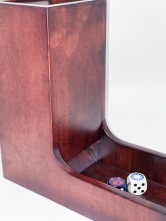Dice Tower Plans Pdf Download Free
The primary goals of a dice tower being • Keeping the dice on the table • Improving the randomization by reducing the ability to manipulate the dice. There are several good designs, however, the basic principle to check for: it should have at least 3 slanted faces, and all the slanted faces should be covered in felt or corduroy. Friction is your friend, here. The shape is almost always an L. Let's compare it to a cowboy boot. • The toe is opened up so that you can see the landing zone. It needs about a 3/4' to 1' high rim.


• The heel has a slanting plate, angled to kick the dice out to the toe. • The shaft of the boot: deflectors. • Plates: The shaft has anywhere from 0 to 5 angled plates within, usually about 30° to 45° downward, angled to toss the dice about in the tower. I don't use ones without at least 2 additional plates.
Most have a top plate, angling down to the front, and a second plate below angled down to the back. The plates should cover about half to 2/3 the cross section. Better designs may have left and right angled plates, or even a narrow center triangle, to toss the dice side to side.
• Dowels: if plates are too much trouble, dowels can be used instead. The dowels should be about 3/8' to 1/2' hardwood, and are placed in levels. Top is usually a front to back and a side to side cross, centered.
1.5'-2' down, 2 off center parallel; a crossing set another 1.5' to 2' down. Taller ones may have additional crosses, or even run dowels corner to corner. • Plastic, Foamcore, Bare Wood, Felt, or Corduroy? What do I cover the thing with? • only the inside of the tower and the tops of the deflectors need covering if you opt to do so, and dowel deflectors can have slipcovers rather than glued down ones. • Bare wood is noisy, and some dice will slide flat along it.
It's acceptable, but not preferred. • Felt: cheap, easy, reduces noise, no nap, so it produces less hang potential than corduroy. Download Championship Manager 2007 Completo Pch. Power Script Mirc Download Italiano 2010 Chevrolet.
Dice tower blueprints. DiceTower1.1.pdf (94 KB) (Log in or Register to download.). Geekdo, BoardGameGeek, the Geekdo logo.
• Corduroy: has a clear nap. This will help catch and tumble the dice. The nap, however, should be arranged to put the lines at a downward angle of 20°-40°, so that the dice also get some sideways motion and better tumble. Probably the quietest of the mentioned materials. • Bare plastic: extremely noisy, very slick.
Least tumble. • Foamcore: as slick as plastic, but not as noisy, but often puts more bounce on the dice. A foamcore sole of the boot can easily result in dice bouncing OUT of a low toe.
(personal experience.) Also, damaged by water, unless sealed with paint or glue. There is another design for a dice tower I've seen used: spiral staircase. Each stair was angled 30° down, and it went clockwise with 1/4' drops off each stair. Being bare wood, it was rather noisy, but it also was very random. Plans & howto's The plans at are decent enough; it's a short 2 deflector boot-style. ??? Jumpstart Dumper ??? Tracker. Plans for a 2 deflector tower.
Building with plaster molded 'stones'. Another set of plans for a square boot. A square castle design, using 3 deflectors. Spiral path in square tower; wood core with polycarbonate sides. Commercially made towers I have one of these! It's noisy as a monkey house. But it's good and random, tho' it lacks side-to-side deflectors.